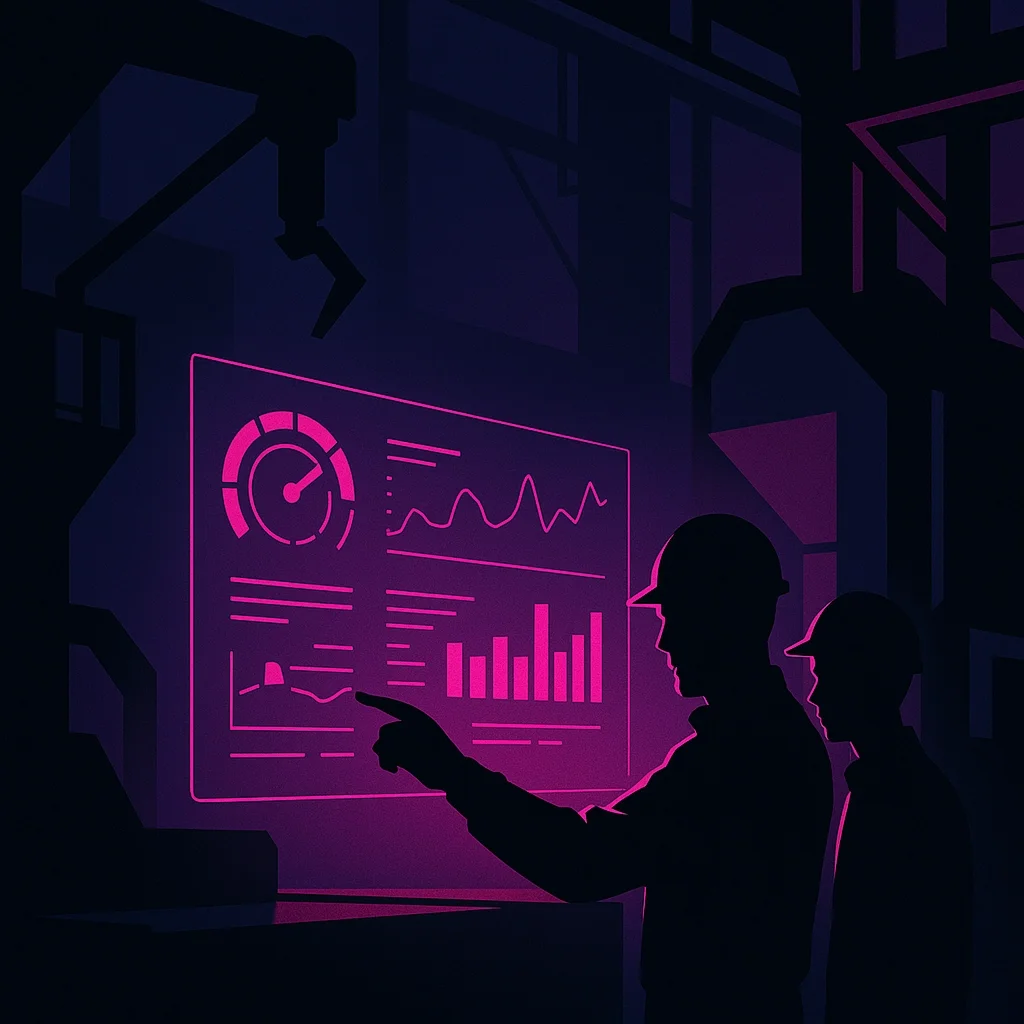From Manual Tasks to Smart Semi-Automation: How Embedded User Research Empowers The Skilled Workforce
The Hidden Value of Tribal Knowledge in Modern Manufacturing
For decades, industrial manufacturing has depended on deep tribal knowledge — the hard-earned, experience-based expertise of skilled workers who know the ins and outs of production better than any manual or software ever could. These workers can hear a machine's subtle change in pitch and know trouble is brewing. They can feel when material quality isn't right. They understand the complex interplay of variables that even the most sophisticated algorithms struggle to capture.
This expertise represents millions of dollars in intellectual capital that rarely gets documented. In fact, according to manufacturing industry reports, up to 70% of factory floor knowledge exists only in the minds of experienced workers.
Yet as digital transformation sweeps through industry, many organizations make a critical mistake: they view automation as a replacement for this human expertise rather than as a powerful complement to it.
The Automation Dilemma: Technology vs. Human Expertise
The promise of automation is compelling — increased efficiency, reduced errors, lower costs. But the reality is more nuanced. When companies implement technology without considering the human element, they often create new problems:
Critical knowledge gaps as systems fail to capture nuanced expertise
Decreased quality when automation handles tasks requiring judgment
Workforce resistance as employees feel threatened rather than empowered
Inflexible processes that cannot adapt to unexpected situations
Expensive investments that deliver disappointing returns
"The most successful digital transformations don't start with technology—they start with people," explains Dr. Maya Hernandez, an industrial psychology specialist. "Understanding how your workforce actually works—not how you think they work—is essential to effective automation."
Embedded User Research: The Bridge Between Human Expertise and Technology
This is where embedded user research becomes transformative. Unlike traditional technology implementation that focuses primarily on technical specifications, embedded user research puts workers at the center of the design process. It recognizes that the people closest to the work have the deepest understanding of it.
Embedded user research in industrial settings involves:
Direct observation of workers in their actual environment, not simulated settings
Participatory design sessions where operators, technicians, and engineers collaborate
Contextual interviews that uncover the "why" behind established procedures
Workflow mapping to identify which tasks benefit from automation and which require human judgment
Prototype testing in real production environments with regular feedback loops
Through this approach, companies discover that the goal isn't to automate everything, but rather to create semi-automated systems where technology and human expertise work in concert.
The Sweet Spot: Smart Semi-Automation
Smart semi-automation distributes work based on comparative advantage. Tasks that demand human judgment, creativity, and adaptability remain with skilled workers, while repetitive, dangerous, or data-intensive tasks shift to automated systems.
For example:
Quality inspection: Automated vision systems flag potential defects, but experienced inspectors make the final call on ambiguous cases
Maintenance: Predictive analytics identify potential equipment failures, while technicians use their expertise to determine the best intervention
Process optimization: AI suggests improvements, but operators with deep production knowledge decide which to implement
Training: Digital systems capture procedural knowledge, while experienced workers teach contextual understanding and troubleshooting
"What we've found is that the most effective automation augments human capabilities rather than replaces them," says Carlos Rivera, a manufacturing technology specialist. "The machine handles the mundane, repetitive tasks, freeing the human to focus on what they do best—adapt, innovate, and make nuanced decisions."
Case Study: Semi-Automation Success in Action
Consider a mid-sized automotive parts manufacturer that was struggling with inconsistent quality and high training costs. Their initial plan was to implement a fully automated inspection system to eliminate human variability.
Through embedded user research, however, they discovered that their most experienced quality inspectors had developed subtle detection techniques that no automated system could replicate. Instead of full automation, they implemented a hybrid approach:
Automated vision systems performed initial screening of all parts
Parts that easily passed or failed were sorted automatically
Borderline cases were routed to expert inspectors
The system continuously learned from inspector decisions, gradually improving its accuracy
The results were impressive:
Defect escape rate reduced by 82%
Inspector productivity increased by 140%
New inspector training time cut in half
Overall quality costs reduced by 35%
Most importantly, quality inspectors who initially feared being replaced became enthusiastic champions of the new system. They found their work more engaging as they focused on challenging cases rather than routine inspection.
How to Implement Embedded User Research in Industrial Settings
Based on our experience at Humanity Innovation Labs, here are key strategies for successfully embedding user research in your industrial transformation:
1. Start With Ethnographic Research
Before proposing any technological solution, invest time understanding the current state through direct observation. Document not just what workers do, but how and why they do it. Look for:
Informal workarounds that don't appear in official procedures
Non-verbal cues that indicate decision-making
Tribal knowledge shared through storytelling and mentorship
"Impossible to automate" tasks that experts insist require human judgment
2. Create Cross-Functional Design Teams
Form teams that include:
Front-line workers who perform the tasks daily
Technical experts who understand automation capabilities
User researchers who can translate between these groups
Business stakeholders who can align solutions with strategic goals
3. Prototype in the Real Environment
Move beyond conference room designs to test solutions in actual production settings:
Create physical or digital mockups that workers can interact with
Run small-scale pilots that can fail safely without disrupting production
Collect both quantitative metrics and qualitative feedback
Iterate based on real-world performance, not theoretical benefits
4. Focus on Augmentation, Not Replacement
Frame the initiative as enhancing human capabilities rather than eliminating roles:
Identify tasks that cause fatigue, stress, or injury
Look for opportunities to provide better information for decision-making
Design interfaces that make complex data accessible and actionable
Create clear handoffs between automated systems and human judgment
5. Build Continuous Learning Loops
Recognize that the perfect solution rarely emerges on the first try:
Establish regular feedback sessions with users
Monitor both technical performance and user experience
Be willing to scale back automation where human expertise proves superior
Document lessons learned for future projects
The Future of Work: Human-Centered Automation
As we look ahead, the most successful industrial organizations will be those that view digital transformation not as a technology project but as a human-centered redesign of work. By embedding user research into automation initiatives, these companies create environments where:
Workers become more productive as technology handles routine tasks
Tribal knowledge is preserved and enhanced rather than lost
New employees can be onboarded more quickly by learning alongside intelligent systems
Innovation accelerates as workers focus on improvement rather than repetition
Workplace satisfaction increases as jobs become more engaging and less physically taxing
"What we're seeing is the emergence of a new relationship between humans and machines in the industrial workplace," explains Dr. Jessica Martin, a workplace futurist. "It's not about machines replacing humans or humans resisting machines. It's about creating symbiotic systems where each contributes what they do best."
Conclusion: The Human Advantage in the Age of Automation
For industrial companies navigating digital transformation, embedded user research offers a powerful approach to modernization that preserves and amplifies the value of human expertise. Rather than pursuing full automation at all costs, the most successful organizations are creating semi-automated environments where technology handles the repetitive while humans focus on the exceptional.
This human-centered approach delivers benefits that purely technical solutions cannot match: smoother implementation, stronger workforce buy-in, more flexible operations, and ultimately, better business results. As technology continues to advance, the competitive advantage increasingly belongs to companies that understand not just what to automate, but what to leave in human hands—and how to create seamless collaboration between the two.
At Humanity Innovation Labs™, we've seen firsthand how this approach transforms not just processes but people. When technology is designed to complement human strengths rather than replace them, the result isn't just a more efficient factory—it's a more engaged, innovative, and resilient organization ready to adapt to whatever challenges the future brings.
Ready to explore how embedded user research can transform your industrial operations? Contact us to learn more about our approach to human-centered automation.




